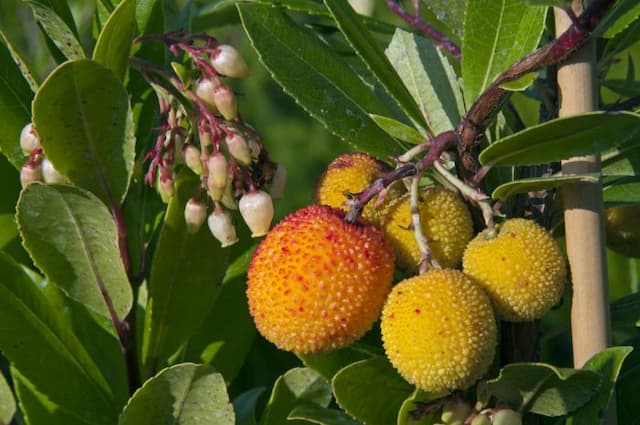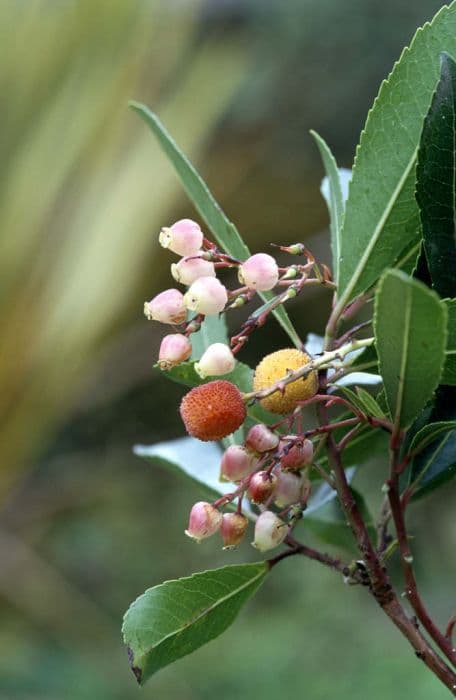Rhododendron Rhododendron (Loderi Group) 'Loderi Game Chick'

ABOUT
The Rhododendron 'Loderi Game Chick' is a captivating shrub that stands out for its luxurious floral display. It boasts large trumpet-shaped flowers that are richly fragrant and generously clustered together, creating a striking visual impact. The blooms exhibit a soft pink hue, which can possess varying intensities, sometimes with a subtler shade on the outside and a more vivid pink towards the throat. These flowers are typically adorned with speckled markings, which add depth and character to the overall appearance. The foliage of 'Loderi Game Chick' consists of broad, leathery leaves that present a deep, lustrous green color. This dense leaf canopy creates an elegant backdrop for the bright blossoms. The leaves are elongated, with a smooth edge and a tapered tip, adding to the plant's graceful structure. As the plant matures, the leaves build a rich tapestry of greenery, complementing the seasonal flush of flowering. Besides the visual appeal, the plant's aromatic presence is noteworthy, often filling the surrounding air with a delightful scent that is most pronounced on warm, sunny days. The memorable fragrance and the showy flowers make Rhododendron 'Loderi Game Chick' a favorite among gardeners seeking to create an eye-catching display in their landscapes. Its blossoming period is typically anticipated with eagerness, as it signifies one of the highlights of springtime in the garden.
About this plant
 Names
NamesFamily
Ericaceae
Synonyms
There are no common names for the cultivar Rhododendron (Loderi Group) 'Loderi Game Chick'; it is known by its scientific name.
Common names
Rhododendron 'Loderi Game Chick'
 Toxicity
ToxicityTo humans
Rhododendrons are known to contain grayanotoxins, which can be poisonous to humans if ingested. Consuming any part of the rhododendron plant can lead to symptoms such as vomiting, diarrhea, abdominal pain, and in severe cases, cardiovascular collapse, coma, and potentially death. It is vital to avoid ingesting any part of the rhododendron and to keep it out of reach of children who might accidentally eat it.
To pets
Rhododendrons are toxic to pets, including dogs, cats, and horses, due to the presence of grayanotoxins. If a pet ingests any part of the rhododendron plant, it could manifest various symptoms such as drooling, vomiting, diarrhea, weakness, and potential heart rhythm abnormalities. The ingestion of rhododendron has the potential to be fatal for pets, so it's imperative to seek veterinary attention immediately if you suspect your pet has consumed this plant.
 Characteristics
CharacteristicsLife cycle
Perennials
Foliage type
Evergreen
Color of leaves
Green
Flower color
Pink
Height
6-8 feet (1.8-2.4 meters)
Spread
6-8 feet (1.8-2.4 meters)
Plant type
Shrub
Hardiness zones
7
Native area
Asia
Benefits
 General Benefits
General Benefits- Aesthetic Appeal: Rhododendrons offer vibrant flowers that can enhance the visual appeal of gardens and landscapes.
- Attracts Wildlife: The blooms can attract pollinators such as bees and butterflies, contributing to the local ecosystem.
- Seasonal Interest: Rhododendrons provide seasonal blooms in the spring, adding color and interest after the winter months.
- Versatile Landscaping: They can be used in a variety of landscaping designs, including borders, hedges, and standalone specimens.
- Shade Tolerant: Many rhododendrons can thrive in partial shade, offering landscaping options in less sunny areas.
- Evergreen Foliage: As evergreen plants, rhododendrons provide year-round greenery, maintaining garden aesthetics even when not in bloom.
 Medical Properties
Medical PropertiesThis plant is not used for medical purposes.
 Air-purifying Qualities
Air-purifying QualitiesThis plant is not specifically known for air purifying qualities.
 Other Uses
Other Uses- As a natural insect repellent: Rhododendron leaves can emit a scent that deters certain insect pests, providing a safe way to protect other plants in the garden.
- In floral arrangements: The large and showy blooms of the Rhododendron can be used in floral arrangements to add volume and a splash of color.
- As a privacy screen: Planting a row of Rhododendron shrubs can create a dense and beautiful screen that adds privacy to your yard.
- For educational purposes: Rhododendrons can be used in schools or educational programs to teach botany and plant biology, due to their complex flower and leaf structures.
- In artistic inspiration: Artists and photographers often use Rhododendrons as subjects in their work due to their vibrant colors and lush foliage.
- As natural dye: Rhododendron flowers can be used to produce natural dyes for fabrics or crafts, yielding delicate shades of pink and purple.
- For bonsai: With proper pruning and care, some Rhododendron varieties can be cultivated as bonsai plants, offering a unique way to display these beautiful plants.
- In cultural festivals: Rhododendrons, in regions where they are native, are often celebrated in festivals and are part of cultural traditions symbolizing spring and rejuvenation.
- As a sound barrier: The dense growth habit of Rhododendron shrubs can help dampen sounds, making them ideal for planting along busy streets or highways.
- In companion planting: Rhododendrons can be planted alongside other acid-loving plants like azaleas and blueberries, helping to create a harmonious and mutually beneficial garden area.
Interesting Facts
 Feng Shui
Feng ShuiThe Rhododendron is not used in Feng Shui practice.
 Zodiac Sign Compitability
Zodiac Sign CompitabilityThe Rhododendron is not used in astrology practice.
 Plant Symbolism
Plant Symbolism- Beware: Rhododendrons, in general, are known to be toxic if ingested. Their symbolism often includes a cautionary note due to their poisonous nature.
- Elegance: The Rhododendron 'Loderi Game Chick' has large, showy blooms, which are often associated with sophistication and refined beauty.
- Abundance: The prolific blooming of the plant can symbolize an abundance of beauty or wealth.
- Warning: The toxicity of the plant gives it a connotation of danger, serving as a warning to be cautious.
- Survival: Rhododendrons are hardy plants that can survive in challenging environments, often symbolizing hardiness and the ability to overcome adversity.
 Water
WaterRhododendrons, including 'Loderi Game Chick', require consistent moisture, but it's crucial not to overwater them. The root system is quite shallow, so the soil should be kept damp but not waterlogged. During the growing season in spring and summer, water the plant about once a week with about one gallon per foot of plant height, making sure to soak the soil thoroughly. In the fall and winter, reduce watering to every other week, or as needed, depending on rainfall and temperature. Always check the soil moisture level a few inches down to ensure the plant is not sitting in water or becoming too dry.
 Light
LightRhododendrons, such as 'Loderi Game Chick', thrive in dappled shade or partial sunlight. They prefer a spot that is shielded from direct afternoon sun, which can scorch their leaves. The ideal location would provide morning sunlight with afternoon shade, or a spot with filtered light throughout the day such as under the canopy of tall trees. Avoid deep shade, as it can lead to poor flowering and leggy growth.
 Temperature
Temperature'Loderi Game Chick' rhododendrons are hardy and can tolerate a range of temperatures but perform best in moderate climates. They can generally withstand winter temperatures down to about 20 degrees Fahrenheit but should be protected from harsh winter winds. During the summer, they prefer temperatures below 80 degrees Fahrenheit. Ideal growing conditions are between 50 and 70 degrees Fahrenheit, which encourages healthy growth and flowering.
 Pruning
PruningPrune 'Loderi Game Chick' rhododendrons to shape the plant, remove dead flowers, and promote bushier growth. Pruning should be done soon after flowering as these plants set next year's flower buds shortly after the current season's blooms fade. It's typically recommended to prune in late spring or early summer. Cut just above the growth nodes on the stems, and avoid heavy pruning as it can reduce flowering the following year.
 Cleaning
CleaningAs needed
 Soil
SoilThe best soil mix for Rhododendron 'Loderi Game Chick' should be well-draining, rich in organic matter, and have a high acidity level with a pH of 4.5 to 6.0. A mixture consisting of 50% peat moss, 30% pine bark, and 20% perlite or coarse sand is ideal to ensure proper drainage and aeration.
 Repotting
RepottingRhododendron 'Loderi Game Chick' should be repotted every 2 to 3 years or when it becomes root-bound. It's best to repot in the early spring before new growth begins.
 Humidity & Misting
Humidity & MistingRhododendron 'Loderi Game Chick' prefers high humidity levels, ideally between 60% and 80%. Consistent humidity near the higher end of this range is beneficial for optimal plant health and bloom.
 Suitable locations
Suitable locationsIndoor
Place in bright, indirect light, ensure high humidity.
Outdoor
Plant in partial shade, shelter from strong winds.
Hardiness zone
7-9 USDA
 Life cycle
Life cycleRhododendron 'Loderi Game Chick' starts as a seed, which upon germination, develops into a seedling with the rudimentary plant parts. As the seedling grows, it matures into a young plant with a set of true leaves and begins to establish a stronger root system. This young plant undergoes vegetative growth, producing a woody stem, more leaves, and branches, gradually forming a shrub. During its mature phase, Rhododendron 'Loderi Game Chick' blooms annually, typically in the spring, producing large, fragrant flowers that are attractive to pollinators. After pollination, the flowers develop into seed pods that eventually release seeds, completing the reproductive cycle. Throughout its life, which can span several decades if properly cared for, the plant may undergo periods of dormancy in the winter, where growth slows or stops temporarily, resuming with warmer temperatures in spring.
 Propogation
PropogationPropogation time
Spring-Early Summer
Propogation: Rhododendron (Loderi Group) 'Loderi Game Chick', commonly known as Rhododendron, is commonly propagated by semi-hardwood cuttings. This method involves taking cuttings from the plant during the late summer, as this is when the current season's growth has started to mature and becomes semi-woody. Cuttings should be about 4 to 6 inches long and include several sets of leaves. The lower leaves are removed, and the cut end is often treated with a rooting hormone to encourage root development. The cutting is then inserted into a well-draining media such as a mixture of peat and perlite. The propagation environment should be kept humid and at a temperature around 65 to 75 degrees Fahrenheit (18 to 24 degrees Celsius), with indirect light until roots have formed.









